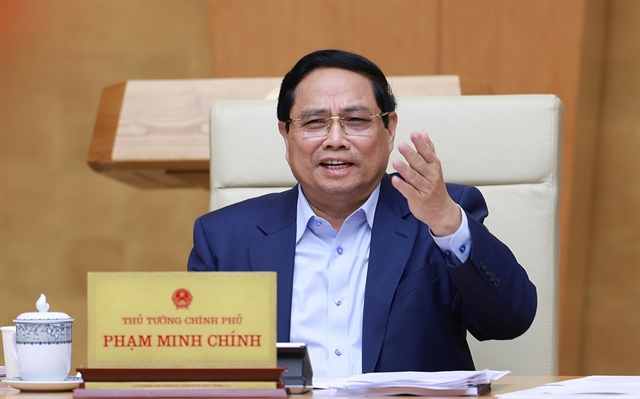.jpg) Politics & Law
Politics & Law


|
| Vietnamese Deputy Prime Minister Trần Lưu Quang (right) and Head of the Communist Party of China (CPC) Central Committee’s Commission for Foreign Affairs and Minister of Foreign Affairs Wang Yi co-chaired the 15th Meeting of the Việt Nam-China Steering Committee for Bilateral Cooperation in Hà Nội on Friday. — VNA/VNS Photo |
HÀ NỘI — The 15th Meeting of the Việt Nam-China Steering Committee for Bilateral Cooperation was held in Hà Nội on Friday under the co-chair of Vietnamese Deputy Prime Minister Trần Lưu Quang and Politburo member, Director of the Communist Party of China (CPC) Central Committee’s Commission for Foreign Affairs and Minister of Foreign Affairs Wang Yi.
At the meeting, the two sides reviewed new development steps in the bilateral relations since the 14th meeting in July 2022, agreeing that the Việt Nam-China comprehensive strategic cooperative partnership has maintained a positive development momentum and achieved many important results.
High-level exchanges and meetings have been organised regularly, notably the historic official visit to China by General Secretary of the CPV Central Committee Nguyễn Phú Trọng in October last year, and high-level visits to China in 2023 by President Võ Văn Thưởng, Prime Minister Phạm Minh Chính, National Assembly Chairman Vương Đình Huệ, and Permanent member of the Party Central Committee's Secretariat Trương Thị Mai.
Exchanges and cooperation through channels of the Party, the Vietnamese National Assembly (NA) and the National People's Congress (NPC) of China, the Việt Nam Fatherland Front (VFF) and the Chinese People's Political Consultative Conference (CPPCC), and between ministries, sectors, people's organisations and localities of the two countries, have been constantly promoted.
China has remained Việt Nam's largest trading partner, while Việt Nam has maintained its position as China's biggest trading partner in ASEAN and the 4th largest in the world. Notably, China became the largest importer of Vietnamese ago-forestry-aquatic products in the first 10 months of 2023. China's investment in Việt Nam has continued to increase. The two sides also expanded cooperation in new fields such as digital economy and green growth, and completed negotiations on many important cooperation documents, including a cooperation plan to connect the "Two Corridors, One Belt” framework with the “Belt and Road” Initiative.
The two sides also pointed out some areas of cooperation that are not commensurate with potential and expectations. They also reviewed the implementation of projects funded by China's non-refundable aid for Việt Nam; and the settlement of prolonged problems and backlogs in a number of industrial cooperation projects.
The two sides discussed cooperation orientations in the coming time, agreeing on the necessity to increase all-level meetings, effectively deploy exchange and cooperation mechanisms between the two Parties, the Vietnamese NA and the National People's Congress (NPC) of China, the VFF and the CPPCC; promote the important role of the two Ministries of Foreign Affairs in coordinating and stepping up areas of cooperation; and effectively deploy defence and security exchange, and law enforcement mechanisms.
They agreed to continue applying effective and practical measures to boost economic, trade and investment cooperation for sustainable and healthy development; increase China’s investment into Việt Nam in fields using advanced, environmentally- friendly technologies; and coordinate to accelerate the implementation of projects using non-refundable aid in Việt Nam.
The two sides also agreed to expand cooperation in the fields of science and technology, environmental protection, transport, agriculture, and health care, culture, education, tourism and people-to-people exchanges; and strengthen mutual support at multilateral forums.
Quang proposed closer coordination between the two sides to improve the efficiency of customs clearance at border gates, crossings and Việt Nam-China border markets; speed up the progress of China's market opening for a number of Vietnamese agricultural and aquatic products; soon complete procedures for establishing a Việt Nam trade promotion office in Haikou in Hainan province of China; and create favourable conditions for Việt Nam to carry out trade and investment promotion activities and attend major trade fairs and exhibitions in China.
He also suggested the two sides accelerate the connection of transport infrastructure, especially the railway, between the two countries; and enhance tourism cooperation to rebound to pre-COVID-19 levels.
Regarding the land border, the two sides held that the sub-committees of the Việt Nam-China Land Border Joint Committee have coordinated closely in the border management work, and promptly discussed and resolved arising issues. The opening and upgrade of border gates have recorded positive results, helping to strengthen the land border and promote socio-economic development in border areas between the two countries.
The two sides frankly discussed issues at sea and agreed to continue to comply with high-level common perceptions, including the Việt Nam-China agreement on basic principles guiding the settlement of sea-related issues, and promote relevant negotiation mechanisms to achieve practical progress.
The Vietnamese Deputy PM emphasised that the two sides need to properly manage and handle differences, respect each other's legitimate rights and interests in accordance with international law, especially the 1982 United Nations Convention on the Law of the Sea (UNCLOS); and join hands with ASEAN member countries to promote negotiations to soon achieve a practical, effective and efficient Code of Conduct in the East Sea (COC) in line with international law and the 1982 UNCLOS, thereby contributing to the maintenance of peace and stability in the East Sea (known internationally as the South China Sea) and the region. — VNS




.jpg)